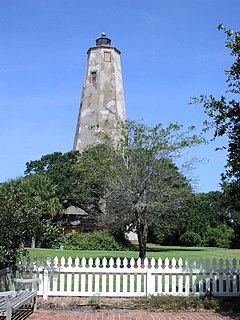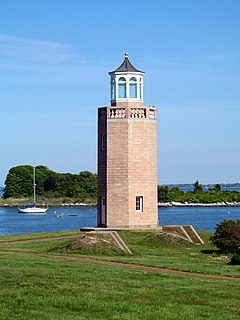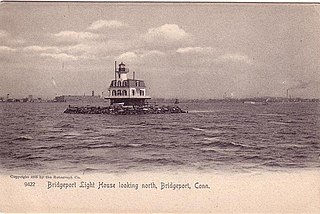Related Research Articles

Falkner Island is a 2.87-acre (1.16 ha) crescent-shaped island located in Long Island Sound 3 miles (5 km) off Guilford, Connecticut, United States. The island has been visited by the Native Americans for thousands of years. Its Quinnipiac name is "Massancummock", meaning "the place of the great fish hawks". In 1641, Henry Whitfield and the founders of Guilford purchased the island from the Mohegan tribe's sachem, Uncas, as part of a transaction for the land east of East River. Purchased by the Stone family in 1715, it remained in the family until it was sold to the government in 1801.
Falkner may refer to:

Bald Head Lighthouse, known as Old Baldy, is the oldest lighthouse still standing in North Carolina. It is the second of three lighthouses that have been built on Bald Head Island since the 19th century to help guide ships past the dangerous shoals at the mouth of the Cape Fear river.

Race Rock Light is a lighthouse on Race Rock Reef, a dangerous set of rocks on Long Island Sound southwest of Fishers Island, New York and the site of many shipwrecks. It is currently owned and maintained by the New London Maritime Society as part of the National Historic Lighthouse Preservation Act program.
The Stewart B. McKinney National Wildlife Refuge is a 950-acre (384.5 ha) National Wildlife Refuge in ten units across the U.S. state of Connecticut. Located in the Atlantic Flyway, the refuge spans 70 miles (110 km) of Connecticut coastline and provides important resting, feeding, and nesting habitat for many species of wading birds, shorebirds, songbirds and terns, including the endangered roseate tern. Adjacent waters serve as wintering habitat for brant, scoters, American black duck, and other waterfowl. Overall, the refuge encompasses over 900 acres (364.2 ha) of barrier beach, intertidal wetland and fragile island habitats.

The Robbins Reef Light Station is a sparkplug lighthouse located off Constable Hook in Bayonne, Hudson County, New Jersey, United States, along the west side of Main Channel, Upper New York Bay. The tower and integral keepers quarters were built in 1883. It replaced an octagonal granite tower built in 1839. The U.S. Coast Guard owned and operated the light station until the 2000s.

Avery Point Light or Avery Point Lighthouse is a lighthouse in Groton, Connecticut, United States, on the Avery Point Campus of the University of Connecticut. Although construction was completed in March 1943, the lighthouse was not lit until May 1944 due to concerns of possible enemy invasion. Its original light consisted of eight 200-watt bulbs that were later replaced by a flashing green light in 1960. It was deactivated on June 25, 1967, when the United States Coast Guard Training Station moved to Governors Island. It is officially listed as the last lighthouse built in the state; the only other claimant is the replica Mystic Seaport Light.

The Bridgeport Harbor Light, later the Bridgeport Harbor Lighthouse, was a lighthouse in Bridgeport, Connecticut, United States. It is located on the west side of the Bridgeport Harbor entrance and the north side of Long Island Sound. Originally constructed in 1851 and rebuilt in 1871 with a dwelling, it had a red-fixed light throughout its service life. The builder and first keeper of the light was Abraham A. McNeil who is also credited as improvising the first light for the Bridgeport Harbor in 1844. By 1953, the lighthouse was in poor condition and the United States Coast Guard opted to build a skeleton tower in its place. In the 2014 edition of the Light List Volume 1, the skeleton tower is marked as "Light 13A" with a height of 57 feet (17 m) and a visual marker of a square green dayboard with a green reflective border. The lighthouse was sold and an attempt was made to move it to serve as a monument for Connecticut's maritime history, but it was later decided to scrap the structure. The lighthouse caught fire and was destroyed during the dismantling in 1953.

Falkner Island Light, also known as the Faulkner Island Lighthouse, is a lighthouse in Connecticut, United States, on Falkner Island which is off Guilford Harbor on Long Island Sound. The lighthouse was constructed in 1802 and commissioned by President Thomas Jefferson. The lighthouse has had three keeper's houses: the original house of 1802 was rebuilt in 1851 and then again in 1871. The 1871 keeper's house survived to 1976, when it was destroyed by fire; the Coast Guard repaired and automated the lighthouse two years later. A volunteer group, the Faulkner's Light Brigade, has undertaken the restoration and preservation of the lighthouse since 1991, completing the last major restoration work in March 2011. Access to Falkner Island and the light is restricted during the nesting season of the roseate terns from May to August yearly. The Falkner Island Lighthouse, as the second oldest extant lighthouse in Connecticut, is listed on the National Register of Historic Places.

Five Mile Point Light, also known as Five Mile Point Lighthouse or Old New Haven Harbor Lighthouse, is a U.S. lighthouse in Long Island Sound on the coast of New Haven, Connecticut. Located at the entrance to New Haven Harbor, the beacon's name derives from its proximity to Downtown New Haven, about five miles (8 km) away. The original lighthouse consisted of a 30-foot (9.1 m) octagonal wooden tower built in 1805 by Abisha Woodward. In 1847, a new 80-foot (24 m) octagonal tower was constructed by Marcus Bassett with East Haven brownstone. This new beacon was illuminated by 12 lamps with reflectors which were positioned 97 feet (30 m) above sea level. Also constructed at this time was a two-and-one-half story brick house which supplanted the previous, deteriorating keeper's dwelling. A fourth-order Fresnel lens replaced the lamps in 1855 and a fog bell was added in the 1860s. The Five Mile Point Light was deactivated in 1877 when the nearby Southwest Ledge Light was completed. Currently, the lighthouse is contained within Lighthouse Point Park and, along with the keeper's house, was listed on the National Register of Historic Places in 1990.

The Lynde Point Light or Lynde Point Lighthouse, also known as Saybrook Inner Lighthouse, is a lighthouse in Connecticut, United States, on the west side of the mouth of the Connecticut River on the Long Island Sound, Old Saybrook, Connecticut. The first light was a 35 feet (11 m) wooden tower constructed by Abisha Woodward for $2,200 and it was completed in 1803. A new lighthouse was eventually needed and a total of $7,500 was appropriated on July 7, 1838. Jonathan Scranton, Volney Pierce, and John Wilcox were contracted to build the new 65-foot (20 m) octagonal brownstone tower. It was constructed in 1838 and lit in 1839. The lighthouse was renovated in 1867 and had its keeper's house from 1833 replaced in 1858 with a Gothic Revival gambrel-roofed wood-frame house. In 1966, the house was torn down and replaced by a duplex house. The original ten lamps were replaced in 1852 with a fourth-order Fresnel lens, and with a fifth-order Fresnel lens in 1890. Lynde Point Lighthouse used whale oil until 1879 when it switched to kerosene. It was electrified in 1955 and fully automated by the United States Coast Guard in 1978. In 1990, it was added to the National Register of Historic Places and is significant for its "superior stone work in the tapering brownstone walls".

Stratford Shoal Light, officially Stratford Shoal Light, is a lighthouse on a shoal in the middle of Long Island Sound approximately halfway between Port Jefferson, New York and Bridgeport, Connecticut.

Black Rock Harbor Light, also known as Fayerweather Island Light, is a lighthouse in Bridgeport, Connecticut, United States which stands on the south end of Fayerweather Island and marks the entrance to Black Rock Harbor. The first lighthouse at the site, built by Abisha Woodward under contract with the United States government, was a wooden tower that was lit and made operational by 1808. A storm destroyed the tower in 1821 and the current, stone lighthouse was erected in its place in 1823. The Black Rock Harbor Light was an active navigational aid until 1933 when it was replaced by two automatic lights offshore. The beacon was subsequently given to the City of Bridgeport in 1934. Two significant efforts during the 1980s and 1990s served to restore the aging tower and the light was relit as a non-navigational aid in 2000. Black Rock Lighthouse is listed as a contributing property for Bridgeport's Seaside Park historic district.

Round Island Passage Light is an automated, unmanned lighthouse located in the Round Island Channel in the Straits of Mackinac, Michigan. The channel is a branch of Lake Huron.

Blackwell Island Lighthouse, now known as Roosevelt Island Lighthouse, also was known as Welfare Island Lighthouse, is a stone lighthouse built by the government of New York City in 1872. It is within Lighthouse Park at the northern tip of Roosevelt Island in the East River. It was named to the National Register of Historic Places on March 16, 1972 and was designated a New York City Landmark on March 23, 1976.

Abisha Woodward (1752–1809), also known as Abashai Woodward, was an architect and contractor from New London, Connecticut that is best known for building lighthouses in the United States. He oversaw the construction of many of Connecticut's earliest lighthouses, but also worked in New York and North Carolina during his career. The oldest surviving beacon built by Woodward is the New London Harbor Lighthouse, which he completed in 1801.

The Lake Borgne Light was a lighthouse in Mississippi at the entrance to Lake Borgne on what is now Lighthouse Point, east of Heron Bay. It was built in 1889 to replace an earlier light on St. Joseph's Island further east, which was shrinking and is now completely gone. The new light sat on a screwpile foundation in the marsh and was reached by a boardwalk; it was equipped with a fifth order Fresnel lens. The house was destroyed by the 1906 Mississippi hurricane but was rebuilt; it was deactivated in 1937 and abandoned. The foundation of the light is marked as a hazard on present day charts, as the point of land has eroded further.
Goose Island is a small, uninhabited rocky island off of the coast of Connecticut, in Long Island Sound. It belongs to the town of Guilford. It is near Falkner Island, North Rocks, Falkner Island Reef, Stony Island, and Three Quarters Rock. Goose Island has eroded to the point that it is 0.5 acre and virtually underwater at high tide, although it was once about 4 acres in size. The strait between the two islands is between 16 and 8 feet deep. The coastline is defined prominently by two small bays that connect during high tide.
References
- 1 2 3 4 5 6 7 8 9 10 11 12 13 14 15 16 17 18 19 20 21 22 23 24 25 D'Entremont, Jeremy. "History of Faulkner's Island Light, Guilford, Connecticut". New England Lighthouses. Retrieved 27 March 2014.
- 1 2 "Faulkner's (Falkner's) Island, CT". Lighthouse Friends. Archived from the original on 25 June 2014. Retrieved 27 March 2014.
- ↑ "Coast Guardsman Returns" (PDF). The Octagon. Spring. 2002.
- 1 2 3 4 5 6 7 8 9 10 11 12 13 14 15 16 17 "Hurricane Hannah Foils Open House '08" (PDF). The Octagon. Spring. 2009.
- 1 2 3 4 5 6 7 8 "Bicentennial Beacon Beams Brightly on Birthday" (PDF). The Octagon. Spring. 2003.
- ↑ Helander, Joel (2010). "Reminiscences of a Coast Guard Lightkeeper Gene Carney's Stint on Faulkner's, 1956-1957" (PDF). The Octagon. Spring.